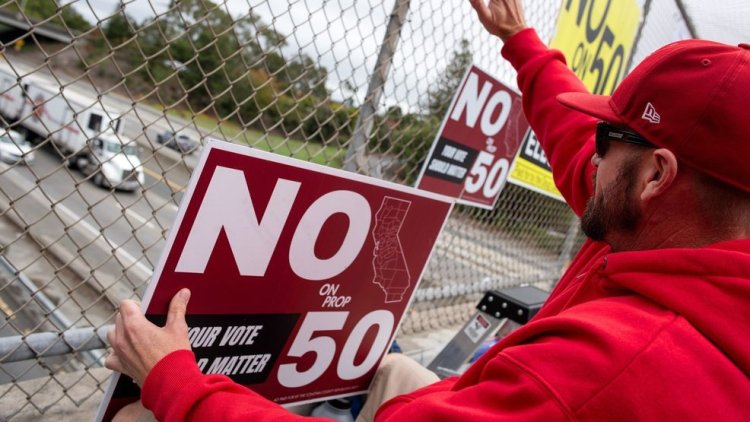California Voters Approve New House Map, Handing Democrats a Strategic Edge for 2026
LOS ANGELES In a decision rippling far beyond the West Coast, California voters on Tuesday approved Proposition 50, a ballot measure redrawing the state’s congressional boundaries and tilting the map in Democrats’ favor ahead of the 2026 midterm elections.

The result delivered a political victory for Governor Gavin Newsom, who cast the measure as a direct counterpunch to Republican-led redistricting drives in states like Texas. For Democrats, it’s more than a local win; it's a lifeline in their uphill fight to reclaim control of the U.S. House and blunt President Donald Trump’s second-term agenda.
A Countermove in a National Tug-of-War
Proposition 50 isn’t just another tweak to electoral lines, it's California’s full-throated response to a nationwide redistricting brawl.
In Texas, Republican lawmakers encouraged by Trump himself recently redrew congressional boundaries to secure five new GOP-leaning seats. California’s Proposition 50 aims to rebalance the scales by giving Democrats the chance to flip as many as five seats of their own.
With Republicans holding a fragile 219-213 edge in the House, every district suddenly carries the weight of national consequence.
“This isn’t about one state,” Newsom said to a cheering crowd in Sacramento on election night. “This is about who gets to define democracy: politicians with erasers, or people with ballots.”
Newsom’s High-Stakes Gamble, Backed by Obama
The governor didn’t just endorse Proposition 50 he owned it. His team poured money, manpower, and political muscle into the campaign, framing it as a stand against partisan manipulation elsewhere.
The measure temporarily suspends California’s independent redistricting commission, a body voters established back in 2008 to take map-drawing out of politicians’ hands and replaces its maps with new ones crafted by the Democrat-controlled Legislature. These will guide congressional elections through 2030.
Former President Barack Obama lent his voice to the campaign, appearing in ads that pulled no punches.
“Republicans want to steal enough seats in Congress to rig the next election,” Obama said. “You can stop them in their tracks.”
The message was blunt and effective. By the final week, Democrats had largely saturated the state’s airwaves. Republicans, short on funding and momentum, were barely visible.
Critics Warn: ‘Two Wrongs Don’t Make a Right’
Yet the move was far from universally celebrated.
Former Governor Arnold Schwarzenegger, the Republican who helped create California’s independent redistricting system blasted Proposition 50 as a betrayal of democratic principles.
“It makes no sense to fight Trump by becoming him,” Schwarzenegger said. “You don’t defend democracy by putting it back in politicians’ hands.”
That criticism found sympathy among some voters wary of partisan tit-for-tat.
“I don’t want Newsom having that kind of control,” said Rebecca Fleshman, a retired medical assistant from Norco. “I voted no. I’m tired of the state being one color. It’s time to even it out.”
Still, the opposition campaign never really caught fire. Outspent and outmaneuvered, its message was drowned out in a sea of Democratic advertising.
Money, Messaging, and Momentum
California campaigns are notoriously expensive, and Proposition 50 was no exception.
Supporters reportedly spent more than $100 million across television, digital, and mail ads while opponents, according to AdImpact data, had virtually no airtime booked.
By mid-October, Newsom’s campaign even asked donors to stop sending checks. The outcome, they said, was already locked in.
AP Voter Poll data confirmed the imbalance: nearly 70% of voters said control of Congress was “very important” to them, and among those voters, Proposition 50 passed by a landslide. Roughly 8 in 10 supporters said they voted “yes” specifically to counter Republican redistricting efforts elsewhere.
The New Map’s Winners and Losers
The political fallout will be swift.
Several long-serving Republican congressmen including Darrell Issa, Ken Calvert, Kevin Kiley, David Valadao, and Doug LaMalfa now find themselves in newly competitive, or even blue-leaning, districts.
Issa responded with characteristic defiance.
“I’m not going anywhere,” he said in a statement. “I’ll keep representing the people of California.”
Calvert accused Newsom of focusing on politics while ignoring Californians’ daily struggles. “This is a power grab,” he said. “Families are being crushed by taxes, rent, and gas prices and the governor’s busy redrawing lines.”
A National Map in Motion
California’s shift is part of a much broader reshuffling.
Republicans are redrawing maps in Texas, North Carolina, Missouri, and Ohio, while Democrats pursue revisions in New York, Illinois, Maryland, and Virginia.
Even Utah, one of the reddest states in the country, has been ordered by a court to produce fairer congressional districts, a move that could, for the first time in years, give Democrats a fighting chance there.
It’s a reminder that redistricting that seemingly dull, bureaucratic process is actually the foundation of modern political power.
A New Citizen’s First Vote
For some, the day carried personal significance beyond politics.
Siddhartha Deb, 52,became a U.S. citizen on Election Day. Moments later, he walked into San Francisco City Hall, registered to vote, and cast his first-ever ballot in favor of Proposition 50.
“It felt symbolic,” he said. “Like I was saying, ‘This democracy is still worth protecting.’”
The Takeaway
California’s approval of Proposition 50 isn’t just a redistricting story — it’s a statement.
It underscores how deeply polarized America has become, and how both parties are willing to fight tooth and nail for every inch of political ground.
For Democrats, it’s a boost in their battle to retake the House.
For Republicans, it’s a warning shot that even solid blue states are willing to bend their own rules when the stakes are this high.
As the dust settles, one truth remains clear: the lines drawn in 2025 won’t just shape California’s political future, they'll help define the nation’s.







